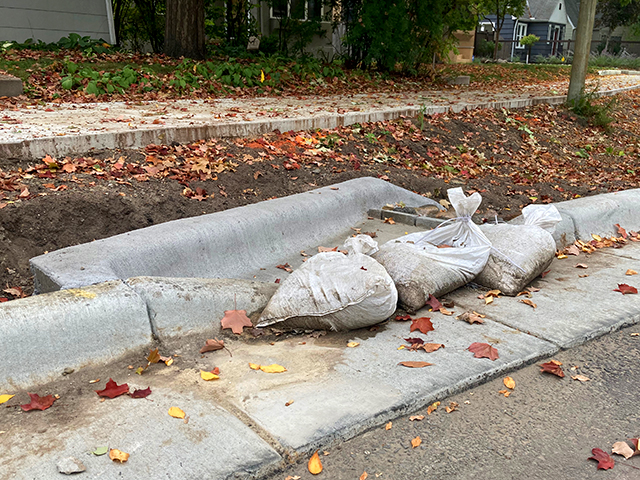If you’ve walked along Grand Avenue in South Minneapolis lately, you may have noticed a subtle change to the boulevards along the newly rebuilt street.
Rather than a continuous curb along the length of the grassy area separating the street from the sidewalk, the boulevards feature cuts into the curb with special drains that will cause water from the street to drain into the boulevard itself, rather than along the gutter into a storm drain.
The boulevard rain gardens — technically known as “bioretention areas” — are part of a citywide effort to take a more eco-friendly approach to managing stormwater runoff. In the two-mile stretch of the Grand Avenue reconstruction, which goes from Lake Street to 48th, the city has installed 126 of the boulevard rain gardens.
Stormwater runoff is easy to ignore in an urban environment. When everything’s working correctly, it runs into storm drains and out of sight. But that water, which can get polluted by everything from lawn fertilizer to car fluids, has to go somewhere. In Minneapolis, it runs to bodies of water like the lakes, Minnehaha Creek and the Mississippi River, where it can damage the aquatic ecosystem and cause excess erosion.
The boulevard rain gardens are designed to lessen the flow of water into storm drains by absorbing some of that polluted water into soil, where it can be filtered by plants and soil and the water returned to the ground. Allison Bell, who oversees the projects as a green infrastructure coordinator between Minneapolis’ Surface, Water and Sewer division and Transportation, Planning and Programming group, likened the gardens to what would have occurred naturally before the city was built up. “The heart of green infrastructure is that it’s trying to mimic what was happening before we developed, before we put roads and houses and buildings,” Bell said. “Water, when it rained, would basically soak into the ground or go into the rivers, lakes and streams without picking up a bunch of pollutants that we’ve now introduced.”
To that end, the rain gardens also make use of native plants. Since native plants are naturally adapted to the ecosystem of the area, they require less maintenance. As an added bonus, the plants combat weeds.
“They’re just more resilient,” Bell said. “And the reason they are is because they have these really deep root structures. So they seek out water like and where sod is four inches into the ground, these go like feet,feet into the ground.”
According to Bell, the bioretention basins along Grand have already stopped nearly 500,000 gallons of water from entering the city’s storm drains.
Rain gardens aren’t the only green stormwater management technique being employed by the city. In some cases, crews are building what are termed “tree trenches” alongside roadways. Tree trenches more closely resemble traditional boulevard plantings in that they have trees, but they also feature curb cuts to allow stormwater to filter into the boulevard soil. Tree trenches were installed in Hoyer Heights in Northeast Minneapolis during road reconstruction last year.

Currently, Bell says installing the rain gardens and tree trenches is a “voluntary effort” by the city. But that will change next year, when a new ordinance requiring this type of stormwater management goes into effect.
The new ordinance means that Minneapolis residents can expect to see a lot more of these types of projects as roads are rebuilt in the coming years. Current projects and those lined up for the next six years are listed on a newly launched site by the department.
For residents who don’t see a project in their neighborhood, Bell said the city is more than happy to guide them in creating their own rain gardens or tree trenches. And while the city won’t fund these projects due to budgeting restrictions, Bell said they will provide resources to guide community members including conducting design reviews.
“If a community wants to take on a project, if it’s something simple, like converting their boulevards into sustainable landscaping, they can actually do that on their own,” Bell said. “They don’t need a permit. They can consult with landscapers if they want to, or they can just do it as a community event. We’ve seen successful programs with that.”


0 Commentaires